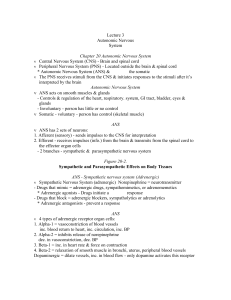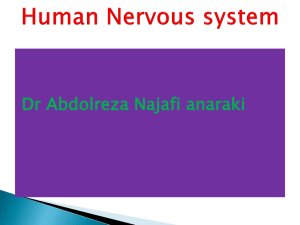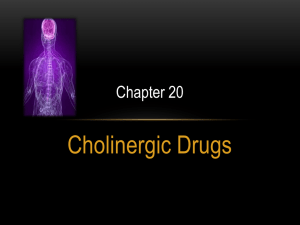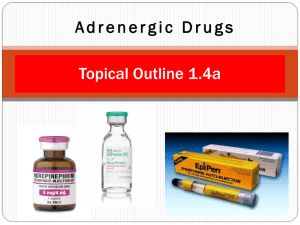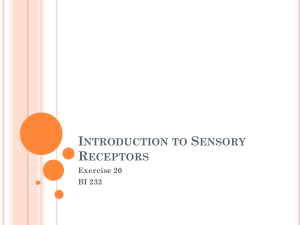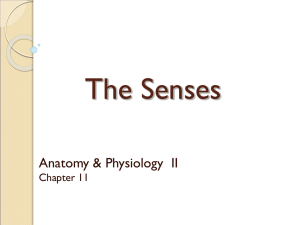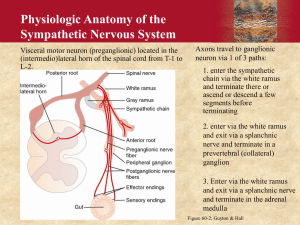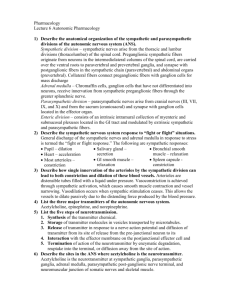Drugs Affecting the Peripheral Nervous System #2
advertisement
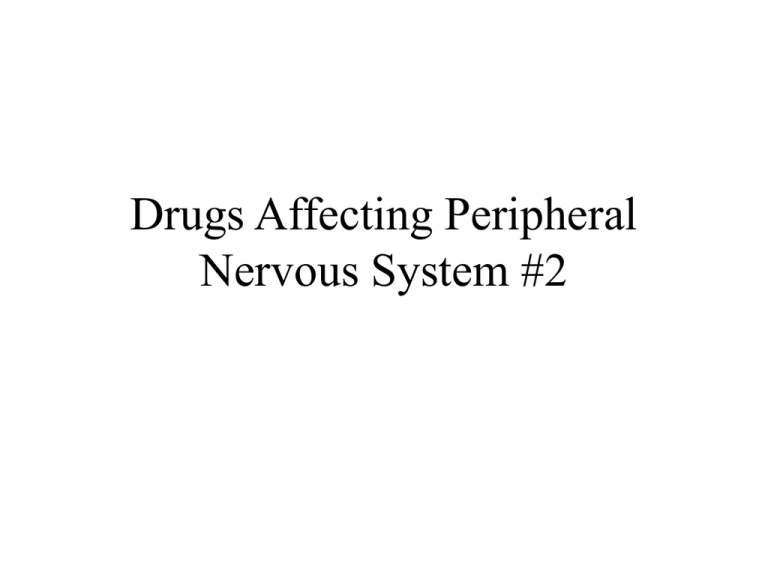
Drugs Affecting Peripheral Nervous System #2 Fight or Flight versus the Parasympathetic Pig Adrenergic Nerve Endings • The adrenergic nerve ending synthesizes and releases norepinephrine (NE) • Released norepinephrine stimulates adrenergic receptors located on cardiac and smooth muscle membranes to initiate sympathetic responses • In emergency situations the adrenal medulla releases epinephrine (EPI) which also stimulates adrenergic receptors and sympathetic activity • NE and EPI are inactivated by neuronal reuptake back into the nerve ending for reuse or metabolism by monoamine oxidase (MAO) – MAOI?? • How do the various tissues distinguish a response to norepinephrine? • Why does the Fight or Flight response excite some tissues and inhibit others? Alpha-Adrenergic Receptors • Alpha-adrenergic receptors are located on smooth muscle membranes and cause smooth muscle contraction when stimulated by NE, EPI, or drugs • Alpha receptor stimulation causes vasoconstriction of most arteries and veins Alpha-Adrenergic Receptors Cont’d • Alpha receptor stimulation of the radial muscle of the pupil causes pupillary dilation or mydriasis • Contraction of the smooth muscle sphincters in the urinary and intestinal tracts inhibit urination and intestinal motility Beta-Adrenergic Receptors • Beta-1 receptors are located primarily in the heart and cause increased heart rate, force of contraction, and atrioventricular conduction • Beta-2 receptors are mostly located on smooth muscle and cause relaxation of smooth muscle, especially bronchiolar and uterine smooth muscle • Beta-3 receptor stimulation also causes vasodilation and increased blood flow to coronary and skeletal muscle blood vessels Table 2.2 Sympathomimetics Norepinephrine and Epinephrine (Catecholamines) • Norepinephrine is released from adrenergic nerve endings and primarily stimulates alpha and beta-1 receptors, it is not effective at beta-2 receptors • Epinephrine is released from the adrenal medulla into the blood where it travels as a hormone to stimulate all alpha and beta receptors Alpha-Adrenergic Drugs • Alpha-adrenergic drugs are used clinically to cause vasoconstriction of blood vessels • In hypotensive states, drugs such as norepinephrine and metaraminol, are given by IV injection to raise blood pressure • In allergies and colds, drugs such as phenylephrine (non-catecholamine) are administered as nasal sprays or drops, and oral tablets to decongest nasal and ocular tissues Alpha Adrenergic Drugs and Indications Ephedrine Nasal Decongestant Methoxamine (Vasoxyl) Increase blood pressure Norepinephrine (Levophed) Increase blood pressure Pseudoephedrine (pseudaphed) Nasal decongestant Tetrahydrozoline (Visine) Opthalmic decongestant Beta-Adrenergic Drugs • Beta drugs are used clinically to stimulate the heart, bronchodilate respiratory passageways, and relax the uterus during preterm labor • Selective beta-2 drugs are usually administered by oral inhalation for the control of asthma • Epinephrine is injected subcutaneously in allergic and cardiac emergencies to stimulate the heart, promote bronchodilation, and maintain blood pressure Beta Adrenergic Drugs and Indications Epinephrine (Adrenaline) Isoproterenol (isuprel) Albuterol (Ventolin) Salmeterol (Serevent) α, β-1, β-2 β β Vasopressor, cardiac stimulant, bronchodilation Cardiac stimulant, bronchodilator Bronchodilator β bronchodilator Indirect and Mixed Agents • Indirect Agents cause release of norepinephrine from nerve ending – Do not bind directly to adrenergic receptor • Mixed Agents cause release of norepinephrine from nerve ending and bind directly to adrenergic receptor • Table 2.1 Adverse Effects Caused by Adrenergic Drugs • The main adverse effect caused by alpha drugs is excessive vasoconstriction resulting in hypertension or excessive dryness of the eyes and nasal sinuses when used as decongestants • Overstimulation with beta drugs causes excessive cardiac stimulation and increased blood pressure • Adrenergic drugs can also cause CNS stimulation resulting in tremors, restlessness, and anxiety Cholinomimetics Cholinergic Nerve Endings • Cholinergic nerve endings synthesize and release acetylcholine (ACH) • Released ACH stimulates cholinergic receptors located on smooth, cardiac, and skeletal muscle membranes to initiate a variety of effects • ACH is inactivated by the enzyme acetylcholinesterase Classification of Cholinergic Receptors • There are three main types of cholinergic receptors • Cholinergic receptors, also referred to as muscarinic, are associated with the parasympathetic nervous system • Nicotinic-neural receptors are located on autonomic ganglia • Nicotinic-muscle receptors are located on skeletal muscle Cholinergic Receptor Actions • Cholinergic receptors are located on smooth and cardiac muscle membranes in association with parasympathetic nerve endings • Parasympathetic nervous activity is associated with body functions during rest and restoration of energy such as eating and digestion • Parasympathetic activity also controls the elimination of waste products from the urinary and intestinal tracts Direct Cholinergic Agonists Direct-Acting Cholinergic Drugs • Direct-acting cholinergic drugs are similar to ACH and stimulate receptors like ACH • Direct-acting drugs have longer durations of action than ACH and are clinically useful • These drugs are used in opthalmology as miotics and in the treatment of glaucoma • Bethanechol stimulates urinary bladder contraction and is taken orally to treat nonobstructive urinary retention Indirect-Acting Cholinergic Drugs • Indirect-acting drugs increase ACH levels at receptors by inhibiting the enzyme acetylcholinesterase • These drugs primarily increase ACH at cholinergic and nicotinic-muscle receptors • Drugs classified as reversible inhibitors of acetylcholinesterase are the most widely used • These drugs are also referred to as anticholinesterase drugs Adrenergic Blockers Cholinesterase Inhibitors Cholinergic Antagonists Ganglion Blockers Autonomic Ganglia • The neural synapses between autonomic pre- and postganglionic nerve fibers are referred to as autonomic ganglia • ACH is the neurotransmitter released at all preganglionic fibers and functions to transmit the nerve impulse to the postganglionic fibers • The receptor on the postganglionic nerve membrane at the ganglionic site is the nicotinicneural (Nn) receptor Drug Actions on Autonomic Ganglia • Drugs that bind to and stimulate Nn ganglionic receptors activate both sympathetic and parasympathetic autonomic nerves • Drugs that block the Nn receptors inhibit the activity of both autonomic divisions • With the exception of nicotine, there are few ganglionic drugs of clinical importance Nicotine and Ganglionic Stimulation • Nicotine, the main active ingredient in tobacco products, is a mild ganglionic stimulant • Both sympathetic and parasympathetic ganglionic Nn receptors are stimulated by nicotine • The main effects of nicotine via smoking are an increase in cardiac and gastrointestinal activity • Nicotine also produces effects in the brain related to the pleasures of smoking and the development of drug dependency Smoking Deterrents • Nicotine containing gum (Nicorette) and transdermal patches (Habitrol, Nicoderm, Nicotrol, ProStep) are used to aid in quitting the smoking habit • The gum or patches are used in decreasing amounts over an 8–12 week time period • Tobacco products should not be used while using these products Ganglionic Blocking Drugs • Ganglionic blocking drugs bind to the Nn receptor and block the effects of ACH at the ganglia • The activity of both autonomic divisions is decreased • The main effects of blockade are decreased blood pressure, heart rate, gastrointestinal, and genitourinary activity • The only clinical use of ganglionic blockers is to lower blood pressure during surgery or in the treatment of severe hypertension Adverse Effects • Ganglionic blockers reduce the activity of the entire autonomic nervous system to produce a wide variety of adverse autonomic effects • Adverse effects include hypotension, decreased cardiac output, constipation, urinary retention, blurred vision, and dry mouth • A significant number of patients cannot tolerate these drugs, which accounts for the limited clinical use Neuromuscular Transmission and Blockade Local Anesthetics

